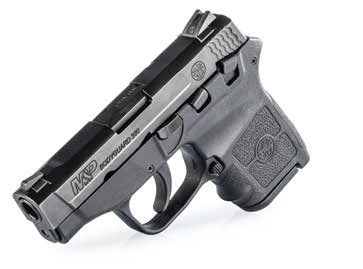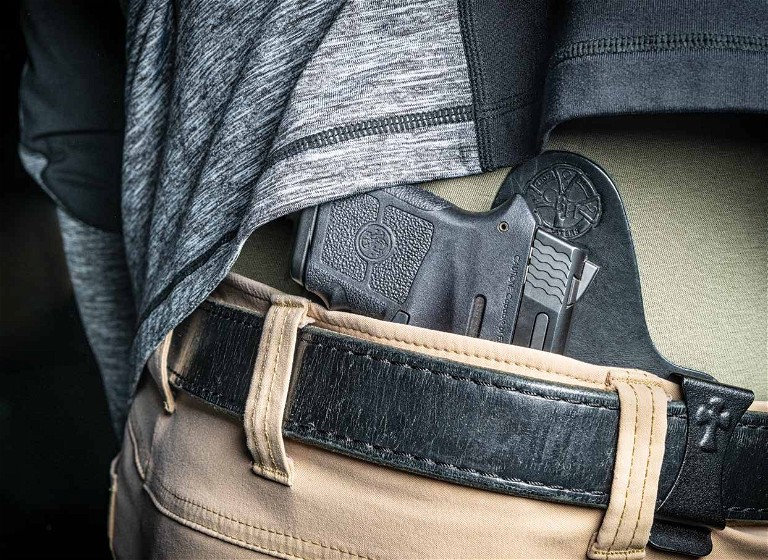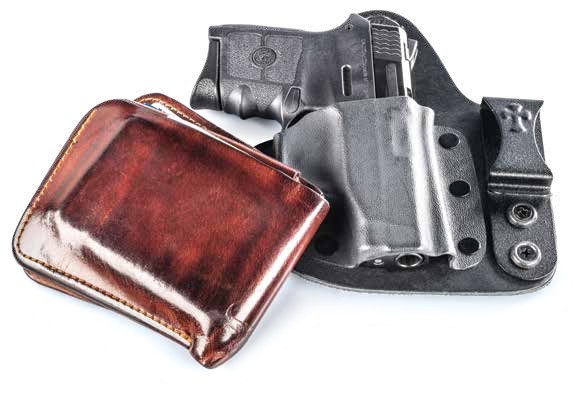BENCH REPORT MARK KAKKURI
MINIMUM PRIMARY OR MAXIMUM BACKUP
SMITH & WESSON M&P BODYGUARD .380

Smallish handguns in smallish chamberings aren’t always relegated to backup roles. Determining the perfect role, however, depends on how such a gun is carried. If it’s in an ankle holster, that’s often more of a backup role. If it’s in a pocket, that’s more of a primary role. S&W’s M&P Bodyguard 380, a 12-ounce handgun chambered in .380, can serve as a primary or backup gun. But if it’s your only gun — your primary — you’ll need to keep just a few key points in mind.
CARRYING
Generally, the smaller the handgun, the less suitable it is for traditional carry in an IWB or OWB holster. Said another way, the smaller the handgun, the more suitable it is for a pocket — one of my favorite locations.
The pros of pocket carry include exceptional concealment and a very comfortable ride. Pocket carry also affords you the ability to put your hand around the stocks inside your pocket. Cons include potentially difficult draws when you’re seated or bending over and the need to keep everything else out of your pocket except the gun and holster. And some pocket holsters tend to ride up with the gun when you draw, letting go only at the end of the draw. This could potentially slow you down.
In a pocket holster in my front pants or shorts pocket, the S&W M&P Bodyguard 380 rides well, standing up with stocks pointed north, ready for my grasp. Depending on the type of pants, it hides well and doesn’t flop. While it does print, it looks like I’m carrying a wallet or a phone — items that don’t draw much attention these days. My wallet and my phone go in the opposite front pocket, stacked, which creates a bit of space for the Bodyguard’s spare magazine, which I carry roundsdown with no holster. My folding knife, which I normally carry in my front pocket (where the Bodyguard now resides), gets moved to my back pocket. Nothing else is allowed in the pocket carrying the Bodyguard.
In pocket, this .380 is noticeable but not uncomfortable. With other items in other pockets, I enjoy a balance of weight. And if anyone is looking closely, he or she will note items in my pockets, but no outline of a gun.

A GUN FOR ALL, BIG OR SMALL
Though the .380 Bodyguard can be carried IWB, as seen here, it is small enough that pocket carry jumps out as a perfect method for rapid acquisition and increased discretion.

WISE INVESTMENT
The Bodyguard 380 in the CrossBreed Freedom Carry IWB holster from Page 23, with a bifold wallet for scale.
SPECIFICATIONS
MODM&P BODYGUARD 380 CALIBER: .380 AUTO CAPACITY: 6+1 SAFETY: MANUAL THUMB SAFETY ACTION: DOUBLE-ACTION-ONLY GRIP: SYNTHETIC SIGHTS: STAINLESS STEEL DRIFT-ADJUSTABLE FRONT AND REAR BARREL LENGTH: 2.75 INCHES LENGTH: 5.3 INCHES WEIGHT: 12 OUNCES BARREL MATERIAL: STAINLESS STEEL SLIDE MATERIAL: STAINLESS STEEL FRAME MATERIAL: POLYMER SLIDE FINISH: ARMORNITE FRAME FINISH: MATTE BLACK
INTO ACTION
Drawing — every step from inserting your hand into your pocket to wrapping your fingers around the stocks to pulling the gun out — requires practice. The pocket holster should be holding the grip frame straight up, allowing for plenty of space between the frontstrap and the holster. As you grasp the stocks (as if going to shoot but with only one hand at this point), pull straight up, allowing the holster to grab the inside of the pocket (if it is of a design that includes tacky material on the holster ’s exterior) and/ or the holster “hook” to catch on the back edge of your pocket, pulling the holster off. It’s not intuitive to move in such a way as to increase friction or engage a physical catch to strip away a holster. But that’s why you have to practice. Once the gun is clear of the holster and pocket, continue the draw and aim as you would as if drawing from a belt-mounted holster.
The S&W M&P Bodyguard 380’s size leaves just enough stock for my medium-large hands. I get two fingers around the stocks, but just barely. The two magazines that ship with this handgun sport two baseplates: one flush and one extended. I opt for the extended baseplate for its extra space for my finger and because, in pocket carry, it doesn’t detract from concealability.
ON THE FIRING LINE
Six plus one rounds of .380 is a formidable defense in the hands of a trained shooter. With the Bodyguard 380, deploying those rounds occurs reliably and consistently — with or without the use of its manual safety. If you present with the safety off, you’ll have a relatively heavy trigger pull to engage before that round is sent. If you present with safety on, it’s a simple 1911-style swipe down of the thumb to disengage the safety and then get on with the trigger pull. The feel and movement of the safety from on to off is sure and clear. Moving the safety switch back on (up) is a bit more difficult.
The trigger pull is fairly long and feels heavy enough that it is difficult to accomplish with the center pad of a trigger finger. In fact, I found that using the crease of my trigger finger afforded me a stronger grip on the gun. In turn, the stronger grip generally yielded more accurate shots (even though I was shooting at targets well inside of 21 feet). Reloads are smooth, and with this pistol, I prefer thumbing the slide release down as opposed to trying to overhand-grasp the slide to chamber a round from a fresh magazine. This pistol offers a second-strike capability in case a first trigger squeeze yields a failure to fire. And if you have to rack the slide, you’d better get a good grip on it. Having the extended base on the magazine that is in the gun improves overall purchase and makes all manipulations easier.
PERFECT FOR THE POCKET
With the right holster and the right placement on the body, the S&W M&P Bodyguard 380 functions well within its intended capabilities. Its light weight, reliable operation and functional manual safety match up well with its diminutive size and extended magazine baseplate. Carried in pocket, it may be a formidable primary or backup handgun in your arsenal.